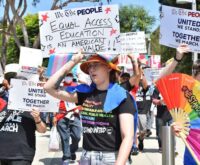What employers don’t know about an office environment — even a virtual one — can hurt themBy Paul M. Igasaki, IMDiversity.com Featured EEO Columnist While I was serving at the Equal Employment Opportunity Commission I got a bird’s eye view of workplace discrimination around the country. There were a great many trends reflecting the changes in our country. Among the most troubling to me, however, has been the increase in racial and ethnic harassment, ranging from insensitive jokes and comments to death threats and assaults. I find this most troubling not because it is more egregious than sexual or other forms of discrimination, but because while sexual harassment has only been a visible problem over the last ten years or so, racial and sexual harassment has been illegal since the passage of the Civil Rights Act in the 1960’s. Racial and ethnic discrimination has become more subtle overall as progress has been made in social standards and in understanding of legal guidelines. Harassment is different. To meet the legal standard of discrimination, the harassment must be offensive enough to interfere with a person’s ability to do their job. It must create a hostile environment for the affected employee. Logic would suggest that these incidents have gone down, but that has not been the case. The EEOC receives from 80,000 to 100,000 charges each year. As Vice Chair, I obviously did not see all of them. But we did examine a good cross section, reviewing statistics as well as the more serious ones or those that we considered litigating. During my eight years at the EEOC, I saw the incidents increase and, in my opinion, worsen. For example, I had never seen incidents involving nooses in my first few years at the EEOC. Yet, by my last three or so, we could count about a dozen such cases each year.
As a visible symbol of coercive racism and implied violence, the display of a noose — placed in work spaces, lockers or vehicles — is one of the few forms of environmental discrimination that is likely to be illegal even as a single occurrence. It carries the symbolic weight of a whole history of lynching in this country to terrorize African Americans and chill exercise of their rights as well as the suggested threat of death. Where action is taken quickly in such cases, there may not be corporate liability, but the fact that these incidents are occurring – and increasingly reported — is very serious. Equally troubling, while the victims responded with understandable fear, anger and seriousness, perpetrators (when they were identifiable) usually claimed that it was just a joke. Most targets of these noose incidents were African American, though at least one was an Asian American. Employers need to understand this “disconnect” between what offenders may view as harmless taunting and what targets experience as painful. The legal standard does not suggest a “splitting the difference,” however. No matter how credible the “humor” is as a motivation, if the harassment creates a hostile environment for a reasonable person of the victim’s background, there might be liability. Consider also that in addition to civil rights ramifications, there may also be tort liability for the perpetrator, especially if it amounts to assault or infliction of emotional distress.
The “New Harassment”
With the widespread use of electronic mail and the casual attitude many take with its use, it is no surprise that harassment of all kinds often takes place over this medium. A request for a date would not be problematic normally, but repeated through interoffice instant messaging ten times a day would be. A racial joke or epithet shared with a whole network becomes “augmented”, carrying far larger consequences than the same expression shared around the water cooler. In addition to racial jokes, epithets used in messages or even in official communications could create a hostile environment. Threats or complaints about racial groups, ethnic groups, immigrants or any other protected group are also more frequent than they had been a few years back. Graffiti also is an all too common problem. Where the message is offensive it could be discriminatory. If the company acts quickly to remove the graffiti and to hold the responsible parties accountable, there might not be liability, but the increased incidents and the intensity of the messages are troubling. Why is this occurring? We have indeed made progress in race relations in this country, but we still have a long way to go. Affirmative Action has achieved Supreme Court sanction and has been embraced by much of corporate America as “good for business.” But, in the public discourse, and among many in society, resentment and frustration are widely expressed, and that resentment has been expressed in less law-abiding ways as well — even to the point of hate crimes. Harassment may also reflect reactions to current events. In the aftermath of the attacks on the World Trade Center and the Pentagon, there was widespread backlash against people of Arab or Muslim American backgrounds, or indeed against people from India or other parts of South Asia, particularly Sikhs. This included fatal hate crimes, but more frequently involved harassment, including in the workplace. I will explore this phenomenon in another column.
Employer’s Responsibility to Know
Employers need to be aware of their responsibilities in knowing the environment and attitudes in their workplace. The courts have found the employer to be in the best institutional position under the law to respond to and hopefully prevent workplace harassment. Not knowing about a situation is no legal excuse if a reasonably diligent employer “should have known” about it. If an incident occurs, acting quickly to maintain a discrimination-free environment may well protect the company from legal difficulties. If there is offensive graffiti, erasing it as quickly as possible to minimize how many people see it would be expected. The same would be true for a noose or offensive email bulletin. Where the harassment is serious enough, suspension or even termination of the perpetrator, if they are known would also be expected. Where an incident is known — and it is important to remember that there are few secrets in the workplace — it is critical that the employer is seen as acting quickly and decisively. Covering up for high-ranking or otherwise productive employees could be a serious problem. Damages awarded in litigation often go up when these actions are not taken. When appropriate actions are taken quickly, employers often escape liability, or at least minimize damages.
While actions must be strong enough to show the employer’s responsibility, one cannot assume guilt by a manager or other employee without risk. Where there is not adequate proof of an employee’s discriminatory behavior and the employer acts too quickly in a public way, the possibility of a defamation suit exists. The importance of a quick investigation should be obvious. Where serious harassment may have occurred, providing the victimized employee with some sense of safety — perhaps separating them from the alleged perpetrator — may make sense pending the investigation. Confidentiality until that investigation is over is also important. Actions may keep things from getting worse. In an environment where workplace violence is also on the rise, sending a message that work is simply not a place where sharing one’s prejudices will be tolerated is critical. It makes sense for an employer to make clear that the company’s culture values diversity and does not tolerate discrimination. The company cannot control its workers’ thoughts, but it is responsible for their actions on the job. Civil rights laws cannot make us love each other, as Martin Luther King, Jr. once said, but they might prevent us from harming each other.
Do You Have a Question about EEO?
Previous EEOCorner Column
|
||||
|

 Paul Igasaki is a consultant in diversity, equal opportunity, government and community affairs. Recently, he edited A Call to Action, a historic policy platform for a coalition of national Asian Pacific American organizations. Appointed by President Bill Clinton, he served as Vice Chair or acting Chair of the U.S. Equal Employment Opportunity Commission from 1994 to 2002, gaining recognition for restructuring the agency to eliminate a crippling case backlog and for building credibility in protecting the rights of immigrant Americans and victims of sexual harassment. He previously served as Executive Director of the Asian Law Caucus in San Francisco and as Washington, D.C. Representative of the Japanese American Citizens League. He also worked for the City of Chicago, his hometown, as a liaison to Asian American communities and as a Mayoral advisor on human relations and affirmative action. His career also included efforts to provide civil legal services to the poor, both at the national level for the American Bar Association supporting collaborations between legal aid and private attorneys and at the local level as a legal services attorney in Sacramento, California. He is an attorney in California and Illinois, and was a graduate of Northwestern University and the University of California, Davis.
Paul Igasaki is a consultant in diversity, equal opportunity, government and community affairs. Recently, he edited A Call to Action, a historic policy platform for a coalition of national Asian Pacific American organizations. Appointed by President Bill Clinton, he served as Vice Chair or acting Chair of the U.S. Equal Employment Opportunity Commission from 1994 to 2002, gaining recognition for restructuring the agency to eliminate a crippling case backlog and for building credibility in protecting the rights of immigrant Americans and victims of sexual harassment. He previously served as Executive Director of the Asian Law Caucus in San Francisco and as Washington, D.C. Representative of the Japanese American Citizens League. He also worked for the City of Chicago, his hometown, as a liaison to Asian American communities and as a Mayoral advisor on human relations and affirmative action. His career also included efforts to provide civil legal services to the poor, both at the national level for the American Bar Association supporting collaborations between legal aid and private attorneys and at the local level as a legal services attorney in Sacramento, California. He is an attorney in California and Illinois, and was a graduate of Northwestern University and the University of California, Davis.








